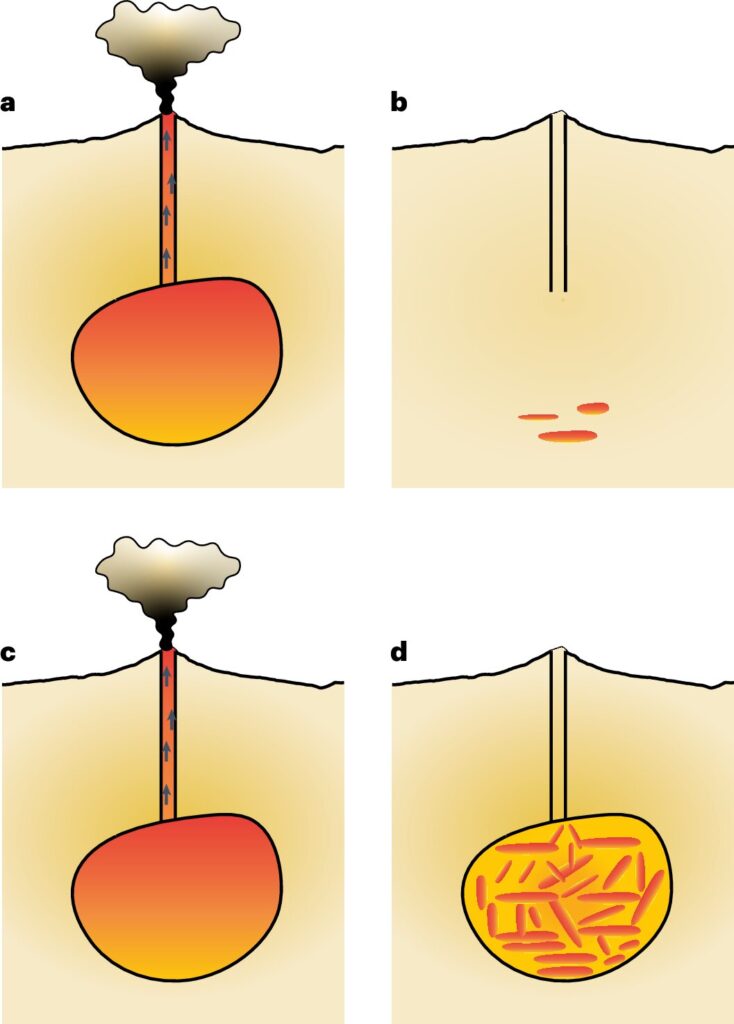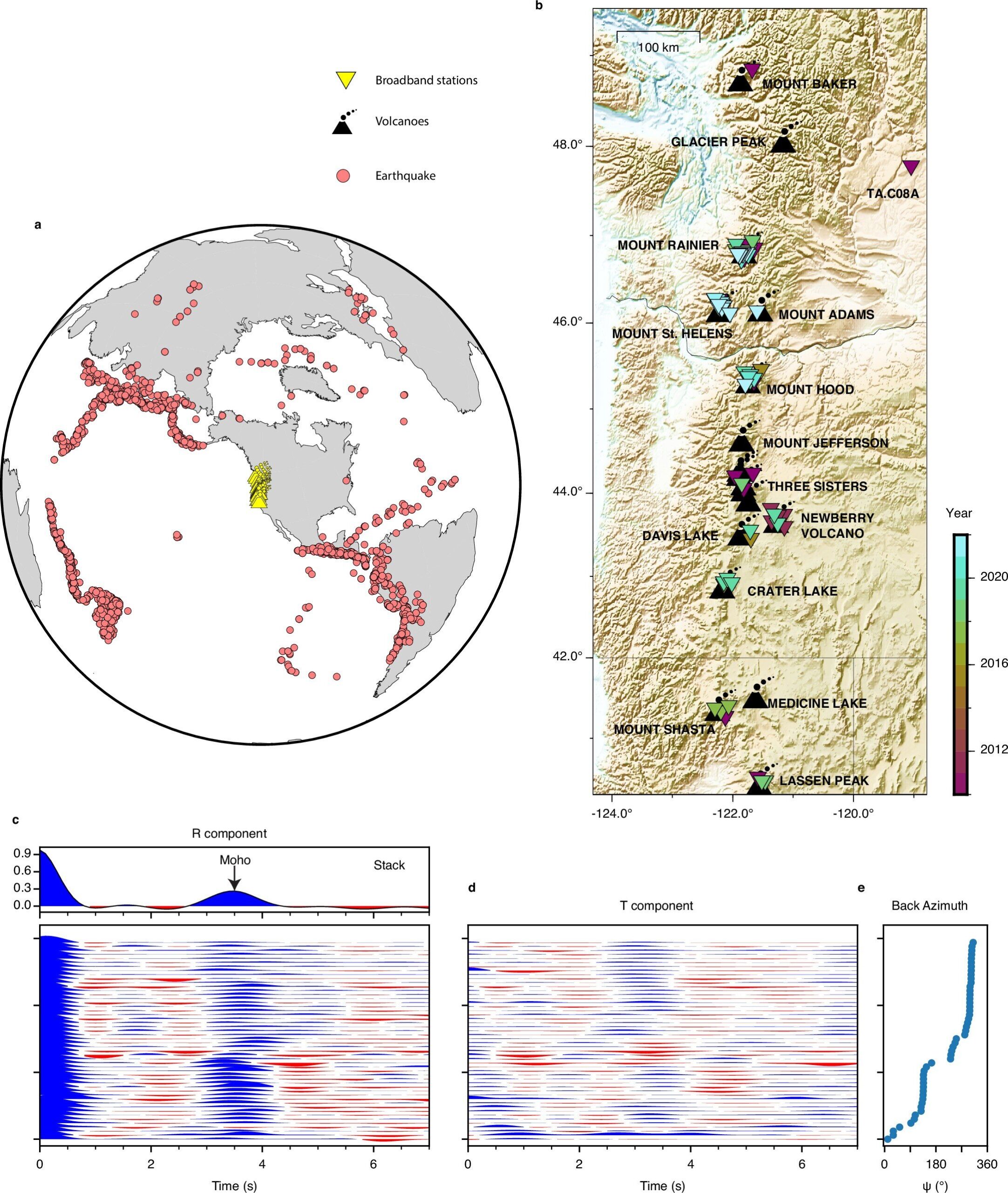In a groundbreaking study led by researchers at Cornell University, a long-held belief about how volcanoes function has been turned on its head. The new findings challenge the conventional understanding that active volcanoes host large magma bodies that are expelled during eruptions, after which these chambers become dormant as volcanoes settle into periods of inactivity. Instead, the study reveals that magma bodies beneath the Earth’s surface persist throughout the lifespan of many volcanoes, even in those that have been dormant for millennia.
The research, spearheaded by Guanning Pang, a postdoctoral researcher, and Geoffrey Abers, a professor in geological sciences, used seismic wave technology to probe the internal structures of six volcanoes within the Cascade Range, a region that is home to half of the U.S. volcanoes classified as “very high threat” by the U.S. Geological Survey (USGS). These volcanoes span various sizes and states of activity, from dormant to more active volcanic systems. The results of this extensive study were published in the prestigious journal Nature Geoscience, providing surprising insights into the geological processes at work beneath the surface.
Surprising Discoveries Beneath Dormant Volcanoes
One of the most striking findings from the study was that all six of the volcanoes examined, including those deemed dormant like Crater Lake in Oregon, were found to harbor large and persistent magma bodies beneath the Earth’s surface. While these volcanoes might not have erupted in thousands of years, seismic waves identified what the research team believes to be sizable and enduring reservoirs of molten rock, or magma, that continue to exist, even long after an eruption.
Historically, scientists believed that magma chambers beneath volcanoes would gradually dissipate over time, especially after major eruptions when large amounts of magma were expelled. As a volcano became dormant, it was assumed that the underlying magma reservoirs would shrink or lose their pressure. However, this new study indicates that large magma chambers are not just a feature of active volcanoes—they appear to persist long after the surface has cooled, even under seemingly dormant volcanoes.
As Pang noted, “Regardless of eruption frequency, we see large magma bodies beneath many volcanoes. It appears that these magma bodies exist beneath volcanoes over their entire lifetime, not just during an active state.” This insight suggests a fundamental shift in our understanding of how magma behaves beneath volcanoes, offering fresh perspectives on volcanic lifecycle and activity patterns.
Implications for Monitoring and Volcanic Prediction
The study also carries significant implications for the monitoring and prediction of volcanic activity. Previously, scientists operated under the assumption that the presence of a large magma chamber signaled an increased likelihood of imminent eruption. The idea was that eruptions were a process through which a volcano expels accumulated magma, and once this was done, the volcano would largely settle down. Now, however, the notion is that magma chambers do not completely empty during eruptions, but rather, a portion of the magma is expelled, with the chamber refilling gradually over time due to the melting of surrounding rock and the ongoing movement of materials from the Earth’s crust.

This discovery is critical in reshaping volcanic monitoring strategies, as researchers aim to detect signs of volcanic unrest before an eruption occurs. Pang suggested, “We used to think that if we found a large amount of magma, that meant increased likelihood of eruption, but now we are shifting perception that this is the baseline situation.” Instead of viewing magma as an indicator of imminent danger, scientists may need to recognize that persistent magma bodies could be the norm beneath many volcanoes, regardless of eruption events.
Understanding that magma chambers do not simply disappear after eruptions has already influenced how volcanologists monitor volcanoes in the Cascade Range—one of the most closely observed volcanic regions in the world. The region has seen a significant investment in monitoring tools as part of the U.S. government’s National Volcano Early Warning System (NVEWS), which was set up to detect seismic or geothermal signals that may indicate volcanic activity.
With this new research, scientists can now more effectively study and track how magma behaves beneath the surface. By identifying the size, volume, and persistence of magma bodies deep within the Earth, geologists can tailor monitoring efforts to better forecast the likelihood of eruptions. This helps ensure that resources are directed efficiently toward understanding which volcanoes may pose the greatest threat, even if they remain dormant for years.
The Role of Seismic Imaging in Unveiling Volcanic Activity
The methodology behind this study was particularly innovative. By utilizing seismic waves, a common tool in geophysics, the researchers were able to map the interior of volcanoes in real-time, gaining insight into magma reservoirs without directly digging or drilling into the ground. Seismic waves, which travel at different speeds through various geological materials, allow scientists to “image” the composition and behavior of rock beneath the surface. By analyzing how these waves interact with the layers of the Earth’s crust, researchers were able to create detailed maps of the locations of magma bodies beneath the surface of the volcanoes studied.
This seismic imaging approach is especially valuable in regions like the Cascade Range, where access to volcanoes can be difficult, and drilling or physical surveys might be impractical. Thanks to the technology, scientists can continue to study volcanoes with much less physical intrusion, allowing for long-term monitoring and observation without significantly disturbing the natural environment.
Furthermore, the new study has broader implications for volcanic research beyond just the Cascade Range. The findings suggest that similar features—persistent magma bodies beneath dormant or less active volcanoes—may be prevalent in volcanic regions across the globe. This realization could reshape volcano monitoring efforts worldwide, with possible applications to volcanoes in Alaska, Indonesia, Italy, and Japan, to name just a few.
Expanding Volcano Monitoring Networks
Following the success of the study in the Cascade Range, researchers are now in the process of expanding their magma monitoring efforts. Pang, Abers, and their team are already working with colleagues in Alaska and other volcanically active regions to further investigate whether these findings apply universally to different types of volcanic systems.
As part of these ongoing efforts, there are plans to enhance the infrastructure for monitoring both the size and morphology of magma bodies, along with increased deployment of advanced seismic detection networks across high-risk volcanic regions. This will help to not only monitor volcanic health but also offer more accurate early warning systems. By tracking how magma chambers evolve over long time spans, scientists may be able to detect subtle changes in volcanic behavior that can help in planning responses to possible eruptions.
As Abers points out, “If we had a better general understanding of where magma was, we could do a much better job of targeting and optimizing monitoring.” As the U.S. Geological Survey (USGS) continues to modernize and expand the National Volcano Early Warning System, this research is seen as an important step forward, providing a deeper understanding of how volcanoes behave at their core and the physical forces at play over geological timescales.
Conclusion: Shifting Perceptions of Volcanic Behavior
The findings from this Cornell University-led study mark a significant shift in how scientists view the dynamics of volcanoes, their magma reservoirs, and their activity. Instead of seeing large magma bodies as unusual or a precursor to eruption, the new model suggests that persistent magma reservoirs may be common beneath many volcanoes, even those that seem dormant. As scientists work to expand volcano monitoring efforts, this discovery could ultimately help enhance predictions and improve public safety in volcanic areas worldwide.
In the coming years, further research will likely unveil more about these magma bodies, revealing how volcanoes evolve and how their behavior may indicate the potential for future eruptions—knowledge that could prove invaluable in protecting communities living in the shadow of these natural giants. The Cascade Range will serve as a key test site for the broader understanding of magma dynamics, and if these findings hold true across other volcanic regions, the shift in how volcanoes are monitored could have profound implications on how we manage volcanic risks globally.
Reference: Guanning Pang et al, Long-lived partial melt beneath Cascade Range volcanoes, Nature Geoscience (2025). DOI: 10.1038/s41561-024-01630-y
